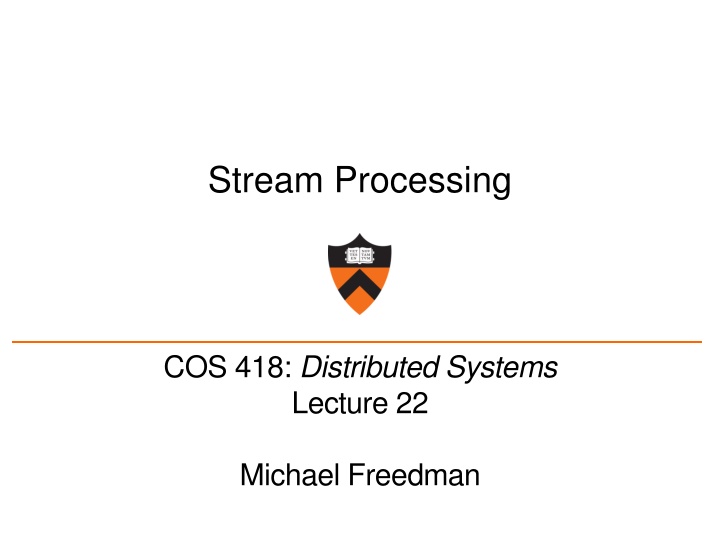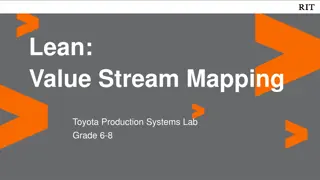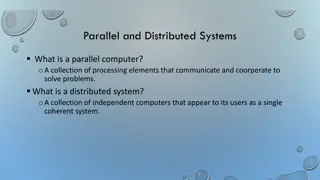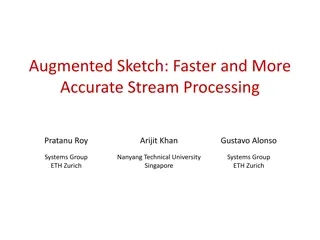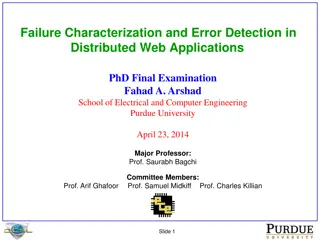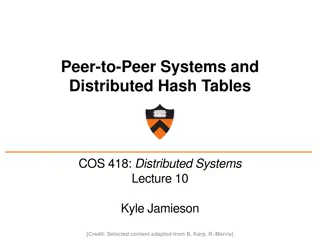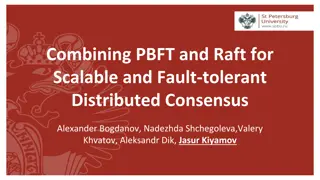Stream Processing in Distributed Systems: Challenges and Examples
Stream processing involves real-time processing of large amounts of data, and is essential for tasks such as social network trend detection, fraud detection, and earthquake monitoring. This summary explores stateless and stateful stream processing techniques, including filtering, conversion, aggregation, and scaling strategies.
Download Presentation

Please find below an Image/Link to download the presentation.
The content on the website is provided AS IS for your information and personal use only. It may not be sold, licensed, or shared on other websites without obtaining consent from the author.If you encounter any issues during the download, it is possible that the publisher has removed the file from their server.
You are allowed to download the files provided on this website for personal or commercial use, subject to the condition that they are used lawfully. All files are the property of their respective owners.
The content on the website is provided AS IS for your information and personal use only. It may not be sold, licensed, or shared on other websites without obtaining consent from the author.
E N D
Presentation Transcript
Stream Processing COS 418: Distributed Systems Lecture 22 Michael Freedman
Simple stream processing Single node Read data from socket Process Write output 2
Examples: Stateless conversion CtoF Convert Celsius temperature to Fahrenheit Stateless operation: emit (input * 9 / 5) + 32 3
Examples: Stateless filtering Filter Function can filter inputs if (input > threshold) { emit input } 4
Examples: Stateful conversion EWMA Compute EWMA of Fahrenheit temperature new_temp = * ( CtoF(input) ) + (1- ) * last_temp last_temp = new_temp emit new_temp 5
Examples: Aggregation (stateful) Avg E.g., Average value per window Window can be # elements (10) or time (1s) Windows can be disjoint (every 5s) Windows can be tumbling (5s window every 1s) 6
Stream processing as chain CtoF Avg Filter 7
Stream processing as directed graph sensor type 1 alerts CtoF Avg Filter sensor type 2 storage KtoF 8
The challenge of stream processing Large amounts of data to process in real time Examples Social network trends (#trending) Intrusion detection systems (networks, datacenters) Sensors: Detect earthquakes by correlating vibrations of millions of smartphones Fraud detection Visa: 2000 txn / sec on average, peak ~47,000 / sec 10
Scale up Tuple-by-Tuple Micro-batch input read if (input > threshold) { emit input } inputs read out = [] for input in inputs { if (input > threshold) { out.append(input) } } emit out 11
Scale up Tuple-by-Tuple Micro-batch Lower Latency Higher Latency Lower Throughput Higher Throughput Why? Each read/write is an system call into kernel. More cycles performing kernel/application transitions (context switches), less actually spent processing data. 12
Scale out 13
Stateless operations: trivially parallelized C F C F C F 14
State complicates parallelization Aggregations: Need to join results across parallel computations CtoF Avg Filter 15
State complicates parallelization Aggregations: Need to join results across parallel computations Sum Cnt CtoF Filter Sum Cnt Avg CtoF Filter Sum Cnt CtoF Filter 16
Parallelization complicates fault-tolerance Aggregations: Need to join results across parallel computations Sum Cnt CtoF Filter Sum Cnt Avg CtoF Filter - blocks - Sum Cnt CtoF Filter 17
Parallelization complicates fault-tolerance Can we ensure exactly-once semantics? Sum Cnt CtoF Filter Sum Cnt Avg CtoF Filter - blocks - Sum Cnt CtoF Filter 18
Can parallelize joins Compute trending keywords E.g., portion tweets Sum / key Sum / key portion tweets Sum / key Sort top-k portion tweets - blocks - Sum / key 19
Can parallelize joins Hash 1. merge 2. sort 3. top-k partitioned tweets portion tweets Sum / key Sum / key Sort top-k portion tweets Sum / key Sum / key Sort top-k portion tweets Sum / key Sum / key Sort top-k 20
Parallelization complicates fault-tolerance Hash 1. merge 2. sort 3. top-k partitioned tweets portion tweets Sum / key Sum / key Sort top-k portion tweets Sum / key Sum / key Sort top-k portion tweets Sum / key Sum / key Sort top-k 21
A Tale of Four Frameworks 1. Record acknowledgement (Storm) 2. Micro-batches (Spark Streaming, Storm Trident) 3. Transactional updates (Google Cloud dataflow) 4. Distributed snapshots (Flink) 22
Apache Storm Architectural components Data: streams of tuples, e.g., Tweet = <Author, Msg, Time> Sources of data: spouts Operators to process data: bolts Topology: Directed graph of spouts & bolts 23
Apache Storm: Parallelization Multiple processes (tasks) run per bolt Incoming streams split among tasks Shuffle Grouping: Round-robin distribute tuples to tasks Fields Grouping: Partitioned by key / field All Grouping: All tasks receive all tuples (e.g., for joins) 24
Fault tolerance via record acknowledgement (Apache Storm -- at least once semantics) Goal: Ensure each input fully processed Approach: DAG / tree edge tracking Record edges that get created as tuple is processed. Wait for all edges to be marked done Inform source (spout) of data when complete; otherwise, they resend tuple. Challenge: at least once means: Bolts can receive tuple > once Replay can be out-of-order ... application needs to handle. 25
Fault tolerance via record acknowledgement (Apache Storm -- at least once semantics) Spout assigns new unique ID to each tuple When bolt emits dependent tuple, it informs system of dependency (new edge) When a bolt finishes processing tuple, it calls ACK (or can FAIL) Acker tasks: Keep track of all emitted edges and receive ACK/FAIL messages from bolts. When messages received about all edges in graph, inform originating spout Spout garbage collects tuple or retransmits Note: Best effort delivery by not generating dependency on downstream tuples. 26
Apache Spark Streaming: Discretized Stream Processing live data stream Split stream into series of small, atomic batch jobs (each of X seconds) Spark Streaming Process each individual batch using Spark batch framework batches of X seconds Akin to in-memory MapReduce Spark processed results Emit each micro-batch result RDD = Resilient Distributed Data 27
Apache Spark Streaming: Dataflow-oriented programming # Create a local StreamingContext with batch interval of 1 second ssc = StreamingContext(sc, 1) # Create a DStream that reads from network socket lines = ssc.socketTextStream("localhost", 9999) words = lines.flatMap(lambda line: line.split(" ")) # Split each line into words # Count each word in each batch pairs = words.map(lambda word: (word, 1)) wordCounts = pairs.reduceByKey(lambda x, y: x + y) wordCounts.pprint() ssc.start() # Start the computation ssc.awaitTermination() # Wait for the computation to terminate 28
Apache Spark Streaming: Dataflow-oriented programming # Create a local StreamingContext with batch interval of 1 second ssc = StreamingContext(sc, 1) # Create a DStream that reads from network socket lines = ssc.socketTextStream("localhost", 9999) words = lines.flatMap(lambda line: line.split(" ")) # Split each line into words # Count each word in each batch pairs = words.map(lambda word: (word, 1)) wordCounts = pairs.reduceByKeyAndWindow( lambda x, y: x + y, wordCounts.pprint() lambda x, y: x - y, 3, 2) ssc.start() # Start the computation ssc.awaitTermination() # Wait for the computation to terminate 29
Fault tolerance via micro batches (Apache Spark Streaming, Storm Trident) Can build on batch frameworks (Spark) and tuple-by-tuple (Storm) Tradeoff between throughput (higher) and latency (higher) Each micro-batch may succeed or fail Original inputs are replicated (memory, disk) At failure, latest micro-batch can be simply recomputed (trickier if stateful) DAG is a pipeline of transformations from micro-batch to micro-batch Lineage info in each RDD specifies how generated from other RDDs To support failure recovery: Occasionally checkpoints RDDs (state) by replicating to other nodes To recover: another worker (1) gets last checkpoint, (2) determines upstream dependencies, then (3) starts recomputing using those usptream dependencies starting at checkpoint (downstream might filter) 30
Fault Tolerance via transactional updates (Google Cloud Dataflow) Computation is long-running DAG of continuous operators For each intermediate record at operator Create commit record including input record, state update, and derived downstream records generated Write commit record to transactional log / DB On failure, replay log to Restore a consistent state of the computation Replay lost records (further downstream might filter) Requires: High-throughput writes to distributed store 31
Fault Tolerance via distributed snapshots (Apache Flink) Rather than log each record for each operator, take system-wide snapshots Snapshotting: Determine consistent snapshot of system-wide state (includes in-flight records and operator state) Store state in durable storage Recover: Restoring latest snapshot from durable storage Rewinding the stream source to snapshot point, and replay inputs Algorithm is based on Chandy-Lamport distributed snapshots, but also captures stream topology 32
Fault Tolerance via distributed snapshots (Apache Flink) Use markers (barriers) in the input data stream to tell downstream operators when to consistently snapshot 33
Optimizing stream processing Keeping system performant: Careful optimizations of DAG Scheduling: Choice of parallelization, use of resources Where to place computation Often, many queries and systems using same cluster concurrently: Multi-tenancy 34
Wednesday lecture Cluster Scheduling 35
